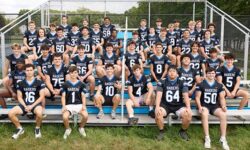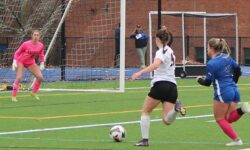By Madison Butkus
Hometown Weekly Reporter
In collaboration with the Dover Historical Society and the Dover Council on Aging (COA), the Dover Town Library (DTL) hosted underwater archaeologist Helena (Laina) Wylde Swiny to discuss Ancient Ships, Shipping and Nautical Archaeology. Attendees gathered together in the Community Room, able to look at an array of ancient ship novelties and eager to hear more about Swiny’s experience within her career.
For this specific presentation, Swiny spoke about the late 4th-early 3rd century BC Kyrenia Ship that sank off the north coast of Cyprus ca. 295 BC. At the beginning, she depicted how many crew members aboard this ship most likely could not swim. Due to the different cargo that was on board, it can be assumed that many of them held onto these items in order to stay afloat.
The shipwreck itself had not been found until 1965 by a man named Andreas Cariolou. When going back to see the ship once again, Cariolou could not locate it, and ended up taking two years total in order for him to find it a second time.
Upon the second finding of the Kyrenia Ship, a team was put together in 1967 to further excavate the ship, lift the cargo and hull, preserve the wood and material, and reassemble the boat back on land. The team, consisting of Swiny, Susan and Michael Katzev, J.R. Steffy, and many more, loaded together on a barge that they would consider their home away from home while on this expedition.
Down below, around 90-100 feet, the ship was sectioned off into squares using some piping materials. The team dived in pairs two times a day: 40 minutes in the morning and 30 minutes in the afternoon. They could only dive for this long due to safety protocols, and there were only certain hours in the day that they could dive due to relying on the sun as natural light under the water.
When diving down, it was crucial that each team worked in their specific square to best work efficiently. Each square was stereo photographed twice within the same day in order to keep proper documentation as they worked.
As the mission went on, many of the student volunteers and/or team members had to return either back to school or work. Though the team grew smaller to eight people, there was still more work that needed to be done. Their next mission was to lift the wood of the ship out of the water and put it into proper treatment. They needed to do this rather quickly as they did not want to leave the ship during the winter months since it could be wrecked further, even that far under the water.
Once they acquired all of the wood out of the water, they washed and stored it with fresh water until it was ready for wax/water mixture treatment. Swiny mentioned that mostly all of the wood had worm holes in it which happened to be a blessing in disguise since the wax could penetrate and give further structural strength to the boards.
After all the wood had been treated, now came the tricky part of putting it back together. Steffy took the lead on this specific project, and with the rest of the team, they were able to reassemble it nearly perfectly as to how they had found it in the water.
As Swiny went through her presentation, audience members asked different questions, including who funded this type of project. She explained that it was through the help of National Geographic and other private foundations. While the government of Cyrus did not fund the project itself, they were very helpful and supportive throughout the process.
Swiny further mentioned that a project like this one could not be done today due to the sheer amount of money that would be needed in order to do so. With this in mind, she was extremely grateful to be a part of this team and do what they were able to do. For those interested in seeing the ship, it and its contents are on display in Kyrenia Castle.






















